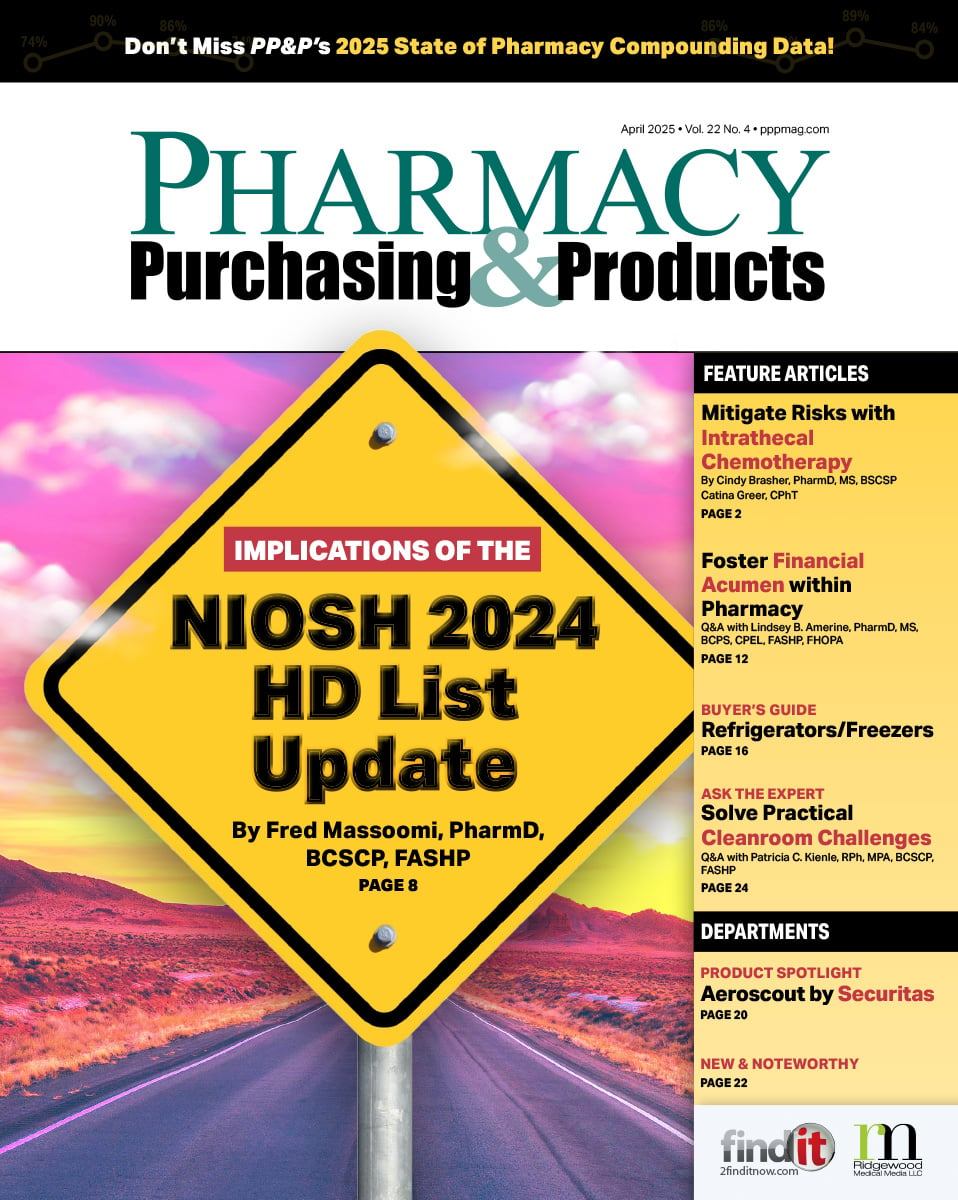- Show Menu
- Contact Us
- FAQs
- Reader Service
- Survey Data
- Survey Winners
- Testimonials
- Upcoming Events
- Webinars
- White Papers
Advancing Safety with Smart Pumps
The ongoing evolution of IV pumps is quite intriguing. Initially, IV pumps were basic devices, focused solely on infusing medications at their programmed rate. There was limited, if any, intelligence built into these devices. Over time, IV pumps have evolved to include advanced drug libraries with the ability to set a variety of infusion rate limits. The drug libraries and associated safety features in the software deliver built-in intelligence, hence the term, smart pumps. It is imperative that pharmacy systematically leverages the advanced safety features available in IV pumps to incorporate the full value of this technology.
Peninsula Regional Medical Center (PRMC) is a 281-bed, level-2 trauma center, acute care community hospital located on the Eastern Shore of Maryland. PRMC has been recognized as one of the nation’s most wired hospitals by the American Hospital Association for 7 consecutive years.1 When we chose to implement smart pumps at PRMC, it became apparent that choosing the best pumps for our organization meant choosing the technology that would best advance our patient-safety efforts.
Selecting a Vendor
Like any important pharmacy technology acquisition, choosing an IV pump vendor requires the efforts of a multidisciplinary team and a structured approach to decision-making. After narrowing the vendor list to three choices, we conducted a vendor fair to obtain hands-on feedback from our end users. The vendor fair occurred over a 2-day period with all vendors simultaneously present. Key components of end users’ scoring during the fair included user efficiency and safety benefits of the drug library software. Results from the vendor fair were incorporated into a comprehensive scoring matrix, which also took into account a variety of additional data, including:
- Pump reliability
- Recall history
- Data analytics capabilities
- Integration with the EHR, the wireless network, and a real-time locating system (RTLS)
- Vendor education and support
- Financial impact on disposables and IV fluids
- A 5-year net present value (NPV) calculation
PRMC’s Smart Pump Decision Matrix is available at www.pppmag.com/smartpumps.
Key IV Pump Features
To fully realize the value this technology can bring to patient safety efforts, all of the safety features must be used to their fullest capabilities. Be sure to review the following key IV pump features during the vendor evaluation process.
Upon turning on the IV pump, users should be directed to utilize the drug library software (see SIDEBAR); the ability to opt in or out of the drug library should not be permitted. This may seem like a small issue, but as one of the most important features of the medication safety software, use of the drug library should be a forced function. This helps ensure that the end users (eg, nurses, anesthesia providers) are following the guidelines and safety parameters established by the clinical team, which ultimately drives safe practices.
Consider utilizing the drug library to establish default values for various settings, such as starting rates and infusion volumes, in order to promulgate standardized practices. This approach is particularly advantageous for routine intermittent medications, such as antibiotics. By establishing default parameters, practice can be standardized among all providers; in addition, limiting user input creates a more efficient process for the end user and also helps reduce device entry errors. Routine doses and infusion times benefit from default settings, as do bolus or loading doses.
Another important feature to utilize in the drug library are the upper and lower soft and hard limits. Soft limits act like speed bumps, as they alert the clinician and require them to slow down and think about an entry, but allow an override if clinical conditions warrant. Hard limits serve as roadblocks, as there is no opportunity to bypass them. With hard limits, the clinician is alerted to a potential issue, and must reprogram the device in order to proceed.
Titration alerts create another opportunity to detect input errors. This feature alerts the clinician when titration changes are too fast or too slow. Because titrated medications often are used in the intensive care unit for our most critical and vulnerable patients, this feature can be a crucial component of patient safety efforts. The titration limit alerts are especially useful in detecting keypad or keystroke errors.
Consider purchasing IV pumps that can offer flexibility depending on the data that is inputted into the device. This is particularly important for medications that are dosed based on the indication. In this scenario, the clinician would be prompted by the IV pump to select an indication. Once selected, the IV pump would display the medication and associated drug library parameters that are specific for the given indication only. This feature also proves valuable for medications, such as potassium chloride, that may be dosed or infused differently when administered via a peripheral versus a central IV line. With this built-in decision tree, the drug library can provide the end user with the appropriate medication parameters depending on the situation.
The process to update the drug library safety software should be discussed by the vendor evaluation team. Wireless updates are preferred, but it is important also to review the process for performing the update to ensure that it is efficient and requires minimal, if any, input from end users. In addition, ensure that drug library updates occur for both active and non-active (ie, turned off) IV pumps.
Continuous Quality Improvement
IV pumps have the ability to provide utilization data sets, which can be leveraged to improve pump performance and identify practice improvement opportunities. These continuous quality improvement (CQI) reports can often be accessed directly from the IV pump server, or in some cases are provided by the vendor.
Commonly available reports include: drug library utilization rates, alerts that result in reprogramming, bypassed alerts, and hard limits attempted for both bolus and infusions. Look for report results that can be viewed both on a facility-wide basis and filtered by clinical care area.
During the IV pump implementation, we set a drug library compliance goal of greater than 95%, a rather ambitious target. With the help of the vendor, along with a committed team of pharmacists, nurses, and physicians at PRMC, we were able to achieve an impressive 99.1% compliance rate at go-live with our drug library.
In drilling down to individual clinical care areas, we noticed that a few areas had drug library compliance rates that did not exceed 80% to 90%. In response, we performed a Gemba walk, a Lean term which means going to the site of the action. To better understand the data, we visited the care areas with low utilization rates and obtained input from end users on how to rectify their processes. By performing the Gemba walk, we were able to improve our facility-wide drug library utilization to 99.3%. A few months later, we had an outstanding 100% compliance with our IV pump drug library.
Performance Benchmarking
Measuring performance against other hospitals is an important tool for validating facility practices, as well as identifying opportunities for improvement. PRMC utilizes Purdue University’s Regenstrief Center for Healthcare Engineering (RCHE)2 as an online resource for benchmarking smart pump performance against hundreds of other facilities. Metrics such as drug library compliance, alerts, library settings, and others can be compared. An institution-specific dashboard is available, which allows the direct upload of data and access to a variety of comparative reports and analytics. Data from calendar year 2015 show that drug library compliance at other facilities ranged from 64% to 100%; the average drug library compliance for all facilities in the database is approximately 85%. For the last 4 months in 2015, PRMC averaged an outstanding 99.7% library compliance.
(To learn more about the smart pump benchmarking database, email remedi@purdue.edu.)
Future Plans
Looking ahead, we plan to work toward improved integration between our IV pumps and our existing information system platforms. With the recent implementation of a new electronic health record (EHR), our current plan is to review the integration capabilities between our IV pump and the new EHR, with the goal of integration within the next 12 months. In addition, we plan to pursue improved integration between our IV pumps and our RTLS. Once the pumps are integrated with the RTLS, this may negate the need to apply a separate RTLS tag on each IV pump. Rather, the integration will allow for near real-time views of IV pump status (eg, indicating whether the pump is on or off, whether the medication has been infused, etc) within the RTLS dashboard.
In closing, not all smart pump software is the same; as such, it is key to choose the pumps that will allow your facility to achieve a high rate of drug library utilization compliance, which ultimately will support your facility’s patient safety goals. It is essential to utilize the intelligence built into these devices to the fullest extent in order to positively impact user efficiency and patient safety.
References
- American Hospital Association. HealthCare’s Most Wired Survey. Hospitals & Health Networks (H&HN) Web site. www.hhnmag.com/mostwired. Accessed March 13, 2017.
- Regenstrief Center for Healthcare Engineering. Purdue University’s Discovery Park. www.purdue.edu/rche. Accessed March 13, 2017.

Dennis Killian, PharmD, PhD, graduated from the University of Maryland-Baltimore School of Pharmacy, obtaining a PharmD in 1999 and a PhD in Pharmaceutical Sciences in 2001. He currently serves as director of pharmacy services at Peninsula Regional Medical Center where he has been employed since 2005. Dennis also serves as an associate professor of pharmacy practice and administration at the University of Maryland Eastern Shore School of Pharmacy since 2010.
SIDEBAR
Drug Library Build
Development of a comprehensive medication library for an IV pump can be a daunting task, as it requires the creation of hundreds of medication entries with multiple variables for each medication. Since most drug libraries are customized to the institution, the use of a drug library from the vendor, if available, or from another site, may provide little value. Therefore, most facilities opt to create a drug library on their own.
The first step in the process is to develop a comprehensive list of the IV medications administered throughout the facility. The list must encompass all IV medications, including chemotherapy and any biological treatments that may be administered in specialized areas of the hospital.
Thereafter, create an initial draft of parameters for each medication. Parameters may include, but are not limited to: hard lower limit, soft lower limit, starting rate, soft upper limit, hard upper limit, concentration, volume to be infused, and bolus dosing options and infusion rates. Develop parameters by reviewing current institutional guidelines, policies and procedures, and general nursing practices.
After a draft library is created, send a review copy to key stakeholders from each hospital area prior to conducting a face-to-face meeting. Schedule a meeting with each area of the hospital individually to review the draft drug library. Thirty to 60 minutes may be required to fully review and vet parameters, and consider medication additions and subtractions for each drug library section. Detailed meeting notes can be documented at each meeting for later implementation, or conversely, the drug library can be updated in real time during the meeting. It is valuable for the vendor to participate onsite in these meetings (although they can call in if necessary) to provide feedback and input.
The final drug library should be approved through a multidisciplinary group, such as the pharmacy and therapeutics committee or similar group. Ongoing changes to the drug library by end users should be encouraged and a process developed to vet, approve, and implement these changes.
Systems Scoop
- Smart Pumps: Baxter SIGMA Spectrum
- Electronic Health Record: Epic Systems
- Real-Time Locating System: Stanley Aeroscout
Like what you've read? Please log in or create a free account to enjoy more of what www.pppmag.com has to offer.








